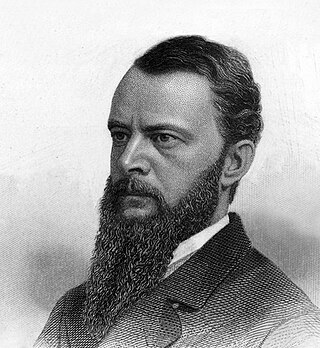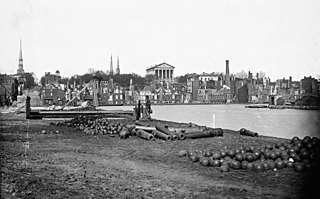
The Confederate States of America (CSA), commonly referred to as the Confederate States or the Confederacy, was an unrecognized breakaway herrenvolk republic in the Southern United States that existed from February 8, 1861, to May 9, 1865. The Confederacy comprised U.S. states that declared secession and warred against the United States during the American Civil War. They were South Carolina, Mississippi, Florida, Alabama, Georgia, Louisiana, Texas, Virginia, Arkansas, Tennessee, and North Carolina.

The flags of the Confederate States of America have a history of three successive designs during the American Civil War. The flags were known as the "Stars and Bars", used from 1861 to 1863; the "Stainless Banner", used from 1863 to 1865; and the "Blood-Stained Banner", used in 1865 shortly before the Confederacy's dissolution. A rejected national flag design was also used as a battle flag by the Confederate Army and featured in the "Stainless Banner" and "Blood-Stained Banner" designs. Although this design was never a national flag, it is the most commonly recognized symbol of the Confederacy.

The Richmond Times-Dispatch is the primary daily newspaper in Richmond, the capital of Virginia, and the primary newspaper of record for the state of Virginia.

Douglas Southall Freeman was an American historian, biographer, newspaper editor, radio commentator, and author. He is best known for his multi-volume biographies of Robert E. Lee and George Washington, for both of which he was awarded Pulitzer Prizes.

The Southern Historical Society was an American organization founded to preserve archival materials related to the government of the Confederate States of America and to document the history of the American Civil War. The society was organized on May 1, 1869, in New Orleans, Louisiana. The society published 52 volumes of its Southern Historical Society Papers which helped preserve valuable historical resources.

The Dahlgren affair was an incident during the American Civil War which stemmed from a failed Union raid on the Confederate capital of Richmond, Virginia in March 1864. Brigardier General Hugh Judson Kilpatrick and Colonel Ulric Dahlgren led an attack on Richmond to free Union prisoners from Belle Isle and damage Confederate infrastructure.
The Virginia Gazette is the local newspaper of Williamsburg, Virginia. Established in 1930, it is named for the historical Virginia Gazette published between 1736 and 1780. It is published twice a week in the broadsheet format.

Edward Alfred Pollard was an American author, journalist, and Confederate sympathizer during the American Civil War who wrote several books on the causes and events of the war, notably The Lost Cause: A New Southern History of the War of the Confederates (1866) and The Lost Cause Regained (1868), wherein Pollard originated the long-standing pseudo-historical ideology of the Lost Cause of the Confederacy.

The Confederate States dollar was first issued just before the outbreak of the American Civil War by the newly formed Confederacy. It was not backed by hard assets, but simply by a promise to pay the bearer after the war, on the prospect of Southern victory and independence. As the Civil War progressed and victory for the South seemed less and less likely, its value declined. After the Confederacy's defeat, its money had no value, and both individuals and banks lost large sums.

The Telegraph, frequently called The Macon Telegraph, is the primary print news organ in Middle Georgia. It is the third-largest newspaper in the State of Georgia. Founded in 1826, The Telegraph has undergone several name changes, mergers, and publishers. As of June 2006, the paper is owned by The McClatchy Company, a publicly traded American publishing company.

The American state of Virginia became a prominent part of the Confederacy when it joined during the American Civil War. As a Southern slave-holding state, Virginia held the state convention to deal with the secession crisis, and voted against secession on April 4, 1861. Opinion shifted after the Battle of Fort Sumter on April 12, and April 15, when U.S. President Abraham Lincoln called for troops from all states still in the Union to put down the rebellion. For all practical purposes, Virginia joined the Confederacy on April 17, though secession was not officially ratified until May 23. A Unionist government was established in Wheeling and the new state of West Virginia was created by an act of Congress from 50 counties of western Virginia, making it the only state to lose territory as a consequence of the war.

Richmond, Virginia served as the capital of the Confederate States of America during the American Civil War from May 8, 1861, hitherto the capital had been Montgomery, Alabama. Notwithstanding its political status, it was a vital source of weapons and supplies for the war effort, as well as the terminus of five railroads, and as such would have been defended by the Confederate States Army at all costs.

The St. Thomas Times-Journal is the city newspaper of St. Thomas, Ontario, Canada, and is owned by Postmedia.

A large contingent of African Americans served in the American Civil War. The 186,097 black men who joined the Union Army included 7,122 officers and 178,975 enlisted soldiers. Approximately 20,000 black sailors served in the Union Navy and formed a large percentage of many ships' crews. Later in the war, many regiments were recruited and organized as the United States Colored Troops, which reinforced the Northern forces substantially during the conflict's last two years. Both Northern Free Negro and Southern runaway slaves joined the fight. Throughout the course of the war, black soldiers served in forty major battles and hundreds of more minor skirmishes; sixteen African Americans received the Medal of Honor.
Edward Carrington Elmore served as the Treasurer of the Confederate States of America during the American Civil War. His signature appears on collectible Confederate currency, and he designed several of the Confederacy's coins.
The Daily Examiner is a daily newspaper serving Grafton, New South Wales, Australia. The newspaper is owned by News Corp Australia. At various times the newspaper was known as The Clarence and Richmond Examiner and New England Advertiser (1859–1889) and Clarence and Richmond Examiner (1889–1915).
The San Francisco Examiner is a newspaper distributed in and around San Francisco, California, and published since 1863.
The Richmond Free Press is an independent newspaper in Richmond, Virginia. Published on a weekly basis, it is mainly targeted at the city's African-American community and its poorest residents. Raymond H. Boone, its founder, started the paper in part because he felt these groups were underrepresented in the mainstream media.

John Moncure Daniel was the US minister to the Kingdom of Sardinia in 1854-1861. However, he is best known for his role as the executive editor of the Richmond Examiner, one of the chief newspapers of the Confederate States of America. Editorials written by Daniel and his editorial board have served as source materials for historians of the American Civil War.
The Richmond Whig was a newspaper published in Richmond, Virginia, between 1824 and 1888.













